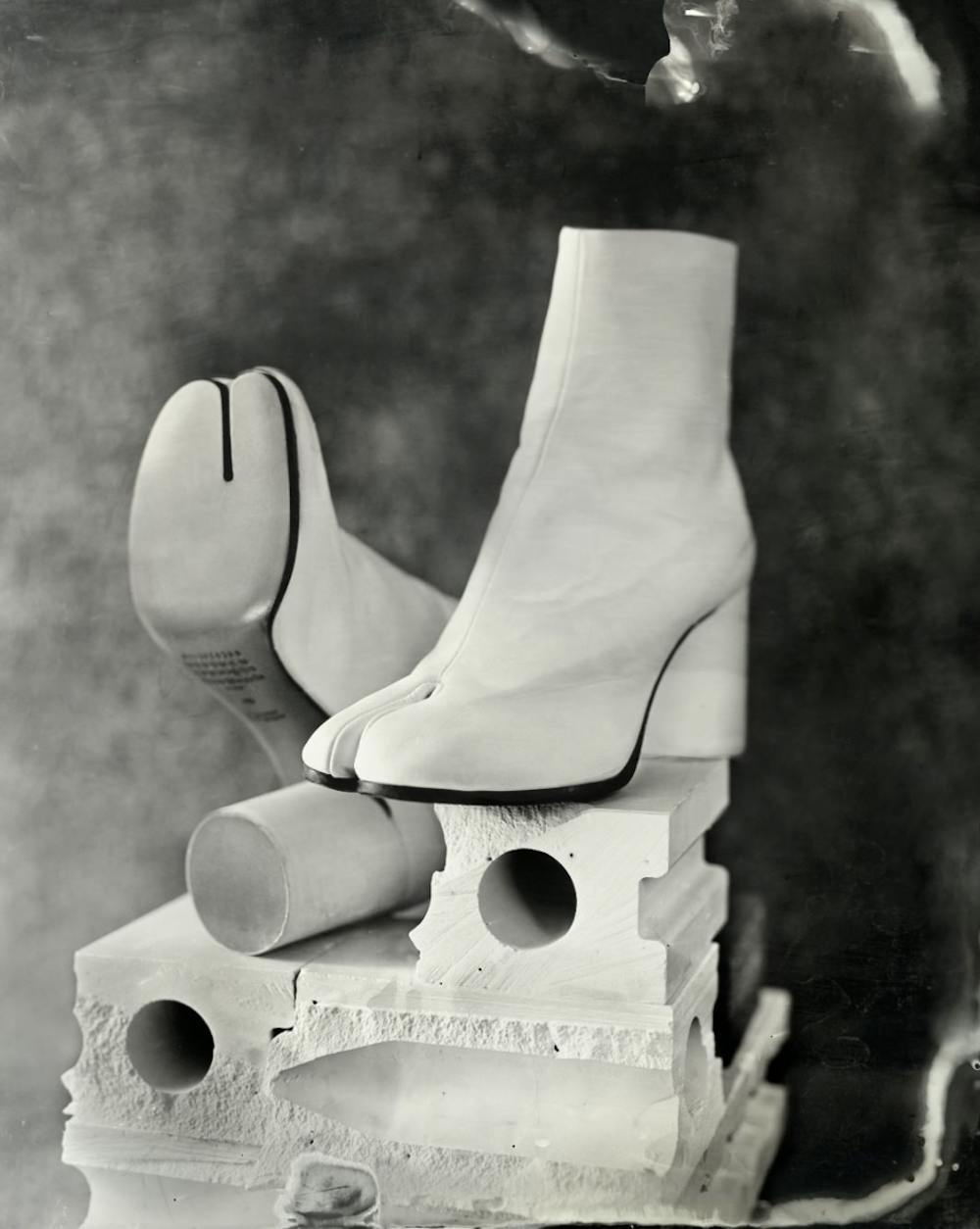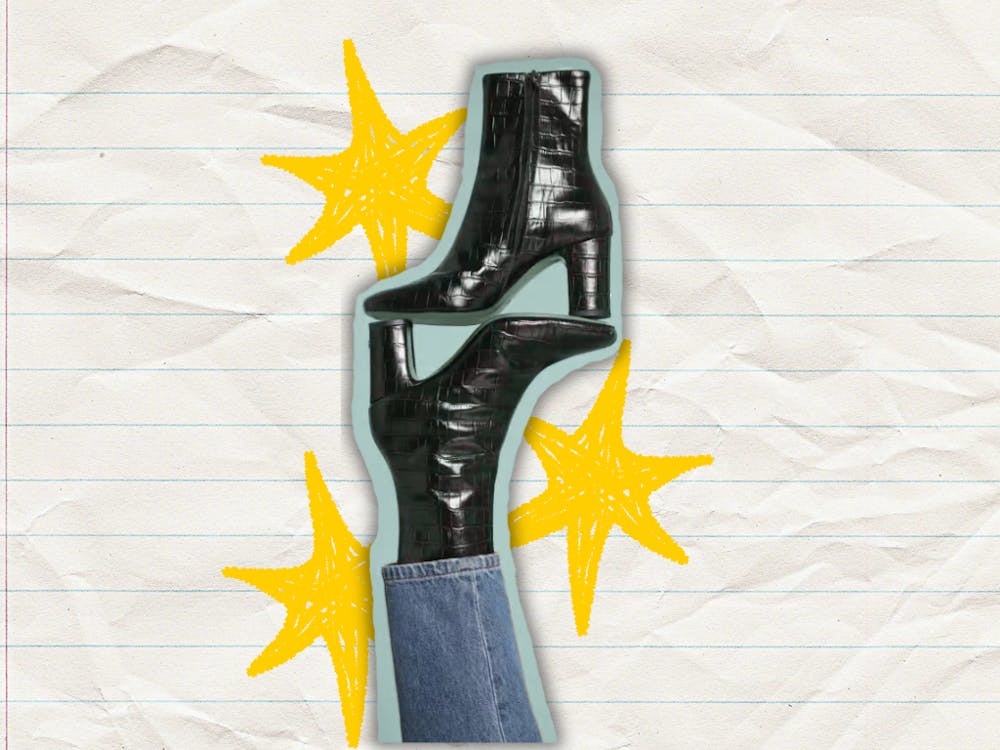The Tabi boot not only has a split toe, but it has also caused a split in public opinion. Constructed of leather panels, a heel, and a hoof-like front, Martin Margiela’s debut footwear offering introduced the fashion house’s most notable silhouette.
But Margiela wasn’t the sole inventor of the Tabi (no pun intended).
The first Tabi socks were created during the 15th century in Japan, when the island nation opened trading with China. The socks, much like the boots today, have a split-toe front, which the public would wear with traditional thonged sandals and kimonos.
Tabi socks were first worn by the upper class. Made up of three fabric pieces, the top two are sewn together above the toe gap while the third is meant for the sole. The socks’ colorway indicated hierarchical status, with the upper class wearing gold and purple and the working class wearing only blue. Samurai were allowed any color, except the elites’ reserved colors. White was a formal color, saved for special occasions.
In 1921, the sock evolved into the Jika-Tabi. Tokujirō Ishibashi designed a rubber sole shoe that ended at the ankles, protecting the feet of manual laborers. Metal closures (Kohaze) secure the shoe at the top, acting like modern buttons. This design is the most similar to Margiela’s silhouette, but Ishibashi created it for functionality rather than for aesthetic.
Ishibashi created a shoe that promoted holistic reflexology for Japanese workers. According to Carmenta Life, holistic reflexology works via the foot to create a balanced and clear mind, as well as battle disease and stress. As the shoe would aid in agility, it benefitted manual laborers and farmers.
Sixty-seven years later, Margiela would introduce the Tabi boot to the world of high fashion.
Before leading his own fashion house, Margiela designed shoes before working for French fashion designer Jean Paul Gaultier. In 1988, Margiela, freshly inspired by the Japanese footwear, was ready to send the Tabi down the runway. But when he introduced the design for the boot, cobblers rejected his idea.
It was not until Geert Bruloot, the first retailer to stock Margiela’s shoe line, introduced him to an Italian craftsman. Mr. Zagato took on Margiela’s idea and handcrafted the Tabi, creating a limited number of pieces.
At the Spring/Summer 1989 show, Margiela wanted to showcase the boot in a way that hadn’t been done before. His models strutted down the runway wearing lab coats and dripping in red paint, while their Tabis left a trail of split-toe footprints.
After the show, Margiela was bombarded with clients requesting the Tabi to come in more colors. “There was no budget for a new form. So I had no other choice than to continue with the style if I wanted shoes,” said Margiela after the positive response. “[But] after several collections people started asking for them. And they wanted more … And they didn’t stop asking, thank God!” For the next season, Margiela repainted the originals due to budget costs.
But it wasn’t only the clients who were inspired by the shoe. A 20 year-old Raf Simons snuck into Margiela’s Fall/Winter 1989 show and “was moved to tears” because of the design. Simons has since become a creative director for Jill Sander, Dior, Calvin Klein, and was deemed one of fashion’s most influential designers.
Enjoy what you're reading?
Signup for our newsletter
As the Tabi became a staple in the Margiela house for the next 30 years, the shoe itself has gone through many different patterns, colorways, and has even become unisex.
Most recently, Tabi has gone through another round of evolution. Reebok has partnered with Margiela for their new collaboration, creating a $358 split-toe dad sneaker.
But this isn’t the first time a Tabi-like style has become sporty. In 1996, Nike created the Air Rift, a split-toe velcro shoe. Once again centered around holistic reflexology, the shoe was inspired by Kenyan runners who would run long-distance barefoot. The shoe was shelved due to unpopularity, but made its comeback in 2015.
Much like any political divide, the Tabi has become a polarizing topic for Internet critics.
“Unpopular opinion: I don’t like Tabi boots,” one Twitter user wrote. “ I like the concept of how it forces you to have an opinion on them because it's unique. You'll either hate it or love it—there's no in between. I like how it's made to be comfortable since it follows the foot's shape. But it looks weird.”
On the other side of the Tabi toe debate, “ My opinions on Margiela Tabi boots have changed,” another Twitter user wrote. “I never would have imagined liking them but now they're all I can think about.”
Love them or hate them, SSENSE’s Arabelle Sicardi said it best when observing the reactions toward her Tabi boots, “Tabi don’t compel apathy— they force you to feel.”




